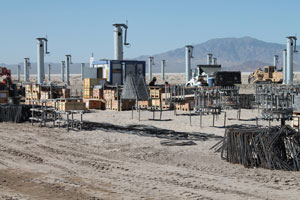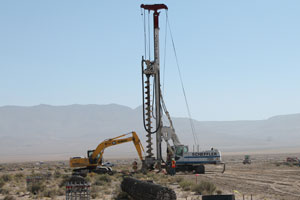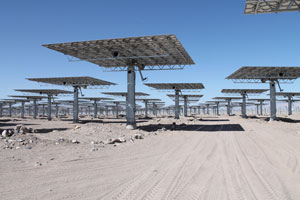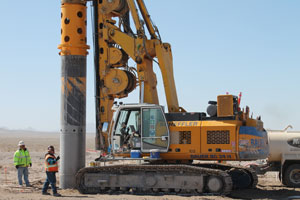Contractor to be honored at international CONEXPO-CON/AGG equipment exposition for making a significant difference for the community’s quality of life
By Mike Porcaro
Building the world’s largest central tower receiver concentrating solar power (CSP) plant near Tonopah, Nevada is bringing new jobs to the area and bolstering its economy, as well as providing energy to customers hundreds of miles away.
When completed, the new Crescent Dunes Solar Energy plant will power up to 75,000 homes with cleaner, cheaper solar energy during peak electricity periods. The majority of clean energy generated will be consumed in northern Nevada.
Tonopah is located halfway between Las Vegas and Reno. “Folks living here realize what a great benefit this plant is to them. They’ve never experienced this before with hotels sold out, restaurants so busy and the feel of excitement,” says Todd Leitel, a project executive with Largo Concrete.
Largo is a full-service structural concrete contractor headquartered in Tustin, CA. The company was a subcontractor placing concrete at the Crescent Dunes project.
 Plant Brings Economic Boost to Region, Provides Clean, Cheap Energy
Plant Brings Economic Boost to Region, Provides Clean, Cheap Energy
The solar plant will generate an estimated $47 million in tax revenues over its first ten years of operation and from secondary induced economic activity for the region. Creation of 4,300 direct, indirect and induced jobs will result. Forty-five full-time, permanent jobs will be created at the new plant along with another 160 related jobs.
Some of the reductions in energy cost will come from the plant’s ability to store energy which can be converted to electricity at anytime over a 24 hour period. This creates operating stability for the NVE power grid while meeting the peak electricity demand.
The environmental impact of using a renewable energy source is far reaching. When the plant is fully operational nearly 290,000 metric tons of carbon dioxide will be eliminated annually, the equivalent to emissions generated by 50,000 vehicles. The new plant will produce enough solar energy to equal about one-quarter of the total output of Hoover Dam.
 Built on 2,700 acres of federal land managed by the Bureau of Land Management, the solar thermal tower is approximately 640 feet in height. It’s comprised of a 540’ high concrete tower with a 100’ tall molten salt receiver erected on top. This receiver contains tubes through which the cold molten salt is heated to over 1,000 degrees F using the reflected sunlight. This heated molten salt is then stored at ground level in specially heated and insulated storage tanks. When power production is required, the hot molten salt is then used to heat water to steam which in turn provides the energy needed to operate the steam turbine/generator, which produces electricity.
Built on 2,700 acres of federal land managed by the Bureau of Land Management, the solar thermal tower is approximately 640 feet in height. It’s comprised of a 540’ high concrete tower with a 100’ tall molten salt receiver erected on top. This receiver contains tubes through which the cold molten salt is heated to over 1,000 degrees F using the reflected sunlight. This heated molten salt is then stored at ground level in specially heated and insulated storage tanks. When power production is required, the hot molten salt is then used to heat water to steam which in turn provides the energy needed to operate the steam turbine/generator, which produces electricity.
Project is Showcase for American Technology
At the time the Nevada project was announced, Kevin Smith, CEO of SolarReserve, a California-based developer of utility-scale solar power projects, said, “The Crescent Dunes Solar Energy Project will be a showcase for American technology, the most advanced solar thermal technology worldwide.”
Tonopah received a $737 million loan guarantee from the U.S. Department of Energy (DOE) with the project breaking ground in August 2011. The tower is expected to be fully operational in 2014.
 Among the tasks on the job-site for Largo Concrete was placement of concrete for 9,348 of the total 10,348 caisson foundations used to support 10,348 heliostat mirrors, which are the devices that reflect the sunlight toward the solar tower. The heliostats on the Crescent Dune project are spread out over a solar field nearly two-miles in diameter.
Among the tasks on the job-site for Largo Concrete was placement of concrete for 9,348 of the total 10,348 caisson foundations used to support 10,348 heliostat mirrors, which are the devices that reflect the sunlight toward the solar tower. The heliostats on the Crescent Dune project are spread out over a solar field nearly two-miles in diameter.
“We placed more than 71,000 yards of concrete on the project,” says Largo’s Todd Leitel, who has been in the concrete construction business for 19 years. In recent years, Largo has performed concrete work on four of the six largest solar projects in the country.
About 600 Construction Jobs Created
Leitel said the challenges on the job were many. “Securing manpower was somewhat of a challenge because the project is located in a very remote desert area,” he said. “However, these are well-paying jobs and at peak, Largo alone employed 145 people.” In total, about 750 construction jobs were created over the nearly 2 1/2-year life of the project with approximately 75 percent of the jobs going to Nevadans.
 Extreme weather conditions were a factor during the seven months Largo spent on the job. “Conditions ranged from working in as much as eight inches of snow to 95-degree heat, and often contending with severe desert sand storms,” says Leitel.
Extreme weather conditions were a factor during the seven months Largo spent on the job. “Conditions ranged from working in as much as eight inches of snow to 95-degree heat, and often contending with severe desert sand storms,” says Leitel.
Through a 25-year agreement signed in 2009 between Solar Reserve and energy company NV Energy, the Crescent Dunes Solar Energy facility will help improve quality of life for Nevadans for years to come.
For contributions to our quality of life, Largo Concrete will be recognized at North America’s largest construction equipment trade show, CONEXPO-CON/AGG. A company representative and one guest will receive a free trip to the show in Las Vegas in March 2014.
At CONEXPO-CON/AGG, they will see all the innovative new equipment that will continue to support their work for better living brought to you by the men and women of the construction industries.
CONEXPO-CON/AGG is the international gathering place in North America for the construction industries. The event features exhibits of the latest technologies and innovations in equipment, products and services plus extensive industry-targeted education. The next CONEXPO-CON/AGG is March 4-8, 2014 at the Las Vegas Convention Center in Las Vegas, USA. More than 100,000 attendees are expected. For more information about CONEXPO-CON/AGG, visit www.conexpoconagg.com.
Tags: CONEXPO-CON/AGG, Crescent Dunes Solar Energy Plant, Largo Concrete, Mike Porcaro, Nevada, NV, Solar, Tonopah






 RSS Feed
RSS Feed